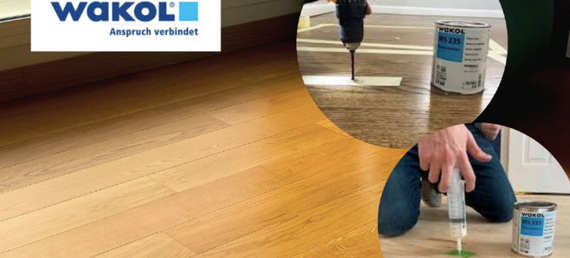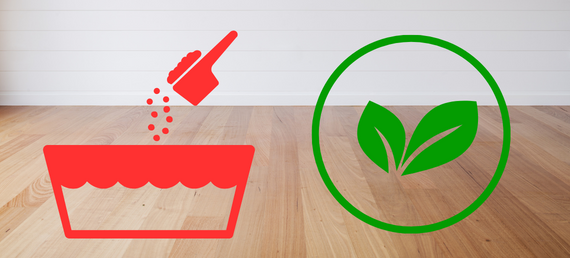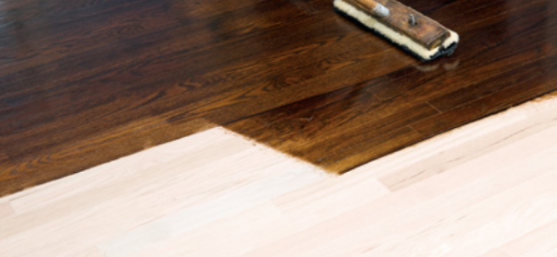The Difference Between Polycures Stains
While finish is designed as a final, clear coat that simply adds a protective covering to your hardwood, stain actually colours the floor, enhancing or sometimes entirely changing the colour of the wood. Polycure have three different stains that can be used to achieve different effects.
Thinning And Colour Adjustment For Stains
When coating a large area, it is recommended that the stain is reduced with either AQUAPRO 1320 Slow Reducer or AQUAPRO 1330 Medium Reducer, this will slow the drying time and allow the stain to flow and level and reduce the risk of roller marks.
IMPORTANT: When the stain is reduced, the colour will be affected, so it is important to prepare a test area prior to application of the whole area.
AQUAPRO & DURASTAIN Stains can be reduced at any addition rate between 1:1 and 1: 6 (1 Part Stain to 6 Parts Reducer).
Always record the amount of reducer added so the stain can be reproduced in the future.
Remember that the final appearance of the stained timber is dependent not only on the stain colour and strength but also on the timber species. The same stain applied on Jarrah and Cypress Pine will results in two totally different colours.
AQUAPRO 2120 Dye Stain
Look / Effect: Bright vibrant colours with excellent clarity.
Appearance: Accentuates the grain
Type: Water based
Suitable For Toning: Yes in AQUAPRO Topcoats
Apply By: Brush, roll, wipe on and leave
AQUAPRO 2120 Dye Stain may be added to a range of Polycure topcoats to deepen the colour of a floor. AQUAPRO 2120 Dye Stain may be added at a rate of 3% (30ml per litre) into AQUAPRO 8068 Hitek or AQUAPRO 8270 Advance 2K Topcoats to enhance the colour of the system.
Important: Do not exceed the suggested addition rate as severe roller marking can occur. Only add unreduced stain into the topcoat.
When sanding a coating that has been toned, it is important to use an even sanding action across the floor using a new 180 grit screen back. Be careful not to cut in one area too much as it can affect the final appearance of the floor.
Application
It is important to apply the stain in one continuous application on the same day. Differences in temperature and environmental effects can result in the stain drying to slightly different colours if it is applied at different times.
Before staining, ensure that all sources of sunlight and heat are removed as this will affect the floor area prior to and during the application of the stain. Seal off any draughts that may cause the stain and coatings to dry faster.
Preparation:
- Prepare a test area to check colour and application.
- Prepare the surface by filling nail holes and imperfections with a water based putty in a colour close to the stain. Allow to dry.
- Sand floor per AS 4786.2-2005 standard to produce a defect and scratch free surface. Finish sanding with 120-180 screen back paper fitted to a rotary sanding machine.
- Ensure floor is defect and scratch free before applying the stain. Scratches and imperfections may be highlighted by the stain.
Staining:
- Reduce and mix enough stain for the entire project before starting. Work from one corner as you would when coating a room. Apply to strip flooring along the direction of the grain. Only cut in a small distance in front of your roller or pad applicator. DO NOT pour or pool stain on the floor.
- Parquetry – apply the stain in an even application across the narrowest part of the floor from side to side until the whole area is stained.
- Even application of the stain is essential to ensure a uniform even colour.
- Allow the stain to dry before applying coatings (see recoat time).
- Ensure adequate coating is applied to seal Dye Stain to reduce the risk of sanding through the sealer coat. If this happens, it is possible to reapply the stain to these areas to recolour the exposed timber.
Thinning And Colour Adjustment For Stains
When coating a large area, it is recommended that the stain is reduced with either AQUAPRO 1320 Slow Reducer or AQUAPRO 1330 Medium Reducer, this will slow the drying time and allow the stain to flow and level and reduce the risk of roller marks.
IMPORTANT: When the stain is reduced, the colour will be affected, so it is important to prepare a test area prior to application of the whole area.
AQUAPRO & DURASTAIN Stains can be reduced at any addition rate between 1:1 and 1: 6 (1 Part Stain to 6 Parts Reducer).
Always record the amount of reducer added so the stain can be reproduced in the future.
Remember that the final appearance of the stained timber is dependent not only on the stain colour and strength but also on the timber species. The same stain applied on Jarrah and Cypress Pine will results in two totally different colours.
AQUAPRO 2770 Pigment Stain
Look / Effect: Soft colour washed, earthy colours or liming effect.
Appearance: Helps to even out differences in the timber.
Type: Water based
Suitable For Toning: No
Apply By: Brush, applicator, wipe on – wipe off excess
Application
It is important to apply the stain in one continuous application on the same day. Differences in temperature and environmental effects can result in the stain drying to slightly different colours if it is applied at different times.
Before staining, ensure that all sources of sunlight and heat are removed as this will affect the floor area prior to and during the application of the stain. Seal off any draughts that may cause the stain and coatings to dry faster.
Preparation:
- Prepare a test area to check colour and application.
- Prepare the surface by filling nail holes and imperfections with a water based putty in a colour close to the stain. Allow to dry.
- Sand floor per AS 4786.2-2005 standard to produce a defect and scratch free surface. Finish sanding with 120-180 screen back paper fitted to a rotary sanding machine.
- Ensure floor is defect and scratch free before applying the stain. Scratches and imperfections may be highlighted by the stain.
Staining:
- Reduce and mix enough stain for the entire project before starting. Work from one corner as you would when coating a room. Apply strip flooring along the direction of the grain. Only cut in a small distance in front of your roller or pad applicator. DO NOT pour or pool stain on the floor.
- Even application of the stain is essential to ensure a uniform even colour.
- The best way to apply the stain is with two people, one applying the stain and the other wiping off the excess. Apply from left to right across the floor.
- In warm weather it is recommended that AQUAPRO 2770 Pigment Stain is reduced at least 1 Part Stain to 2 Parts Reducer. – Note this will reduce the depth of colour.
- Allow the stain to dry before applying coatings (see recoat time).
- Ensure adequate coating is applied to seal AQUAPRO 2770 Stain to reduce the risk of sanding through the sealer coat. If this happens, it is possible to reapply the stain to these areas to re-colour the exposed timber.
Note: Failure to remove all excess stain will result in an uneven patchy appearance. The stain must be totally dry before over coating or adhesion will be compromised.
Thinning And Colour Adjustment For Stains
When coating a large area, it is recommended that the stain is reduced with either AQUAPRO 1320 Slow Reducer or AQUAPRO 1330 Medium Reducer, this will slow the drying time and allow the stain to flow and level and reduce the risk of roller marks.
IMPORTANT: When the stain is reduced, the colour will be affected, so it is important to prepare a test area prior to application of the whole area.
AQUAPRO & DURASTAIN Stains can be reduced at any addition rate between 1:1 and 1: 6 (1 Part Stain to 6 Parts Reducer).
Always record the amount of reducer added so the stain can be reproduced in the future.
Remember that the final appearance of the stained timber is dependent not only on the stain colour and strength but also on the timber species. The same stain applied on Jarrah and Cypress Pine will results in two totally different colours.
DURASTAIN 2025 Dye Stain
Look / Effect: Bright vibrant colours with excellent clarity.
Appearance: Accentuates the grain.
Type: Solvent based
Suitable For Toning: Yes in DURAPOL Gloss, TITAN Gloss & POLYTHANE Two Pack.
Apply By: Brush, roll, wipe on and leave
DURASTAIN 2025 Dye Stain may be added to a range of Polycure topcoats to deepen the colour of a floor. DURASTAIN 2025 Dye Stain may be added at a rate of up to 3% (30ml per litre) in the second coats of DURAPOL Gloss or TITAN Gloss.
Important: Do not exceed the suggested addition rate as severe roller marking can occur. Only add unreduced stain into the topcoat.
When sanding a coating that has been toned, it is important to use an even sanding action across the floor using a new 180 grit screen back. Be careful not to cut in one area too much as it can affect the final appearance of the floor.
Thinning And Colour Adjustment For Stains
When coating a large area, it is recommended that the stain is reduced with either AQUAPRO 1320 Slow Reducer or AQUAPRO 1330 Medium Reducer, this will slow the drying time and allow the stain to flow and level and reduce the risk of roller marks.
IMPORTANT: When the stain is reduced, the colour will be affected, so it is important to prepare a test area prior to application of the whole area.
AQUAPRO & DURASTAIN Stains can be reduced at any addition rate between 1:1 and 1: 6 (1 Part Stain to 6 Parts Reducer).
Always record the amount of reducer added so the stain can be reproduced in the future.
Remember that the final appearance of the stained timber is dependent not only on the stain colour and strength but also on the timber species. The same stain applied on Jarrah and Cypress Pine will results in two totally different colours.




